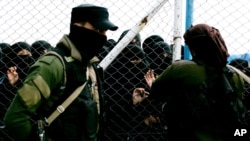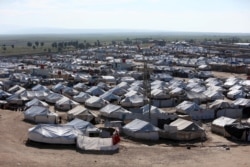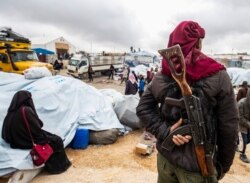A combination of rising bloodshed and increased criminal activity at displaced-persons camps in northeastern Syria has gotten the attention of U.S. officials, who fear security forces are losing the battle to contain supporters of the Islamic State terror group.
U.S. officials, speaking on the condition of anonymity because of the nature of the intelligence, blame recent killings — including at least one beheading and multiple execution-style killings — on IS operatives and supporters, warning they are now rapidly turning camps like the densely populated al-Hol into a base for the terror group’s operations.
And they caution the brutal violence, long a hallmark of IS, is just part of the problem.
“Security services at al-Hol have struggled to address ISIS recruitment and fundraising,” one U.S. official told VOA, using an acronym for the terror group.
The camp’s perimeter is also proving to be increasingly porous.
“ISIS has moved ISIS families out of al-Hol using smuggling networks in Hasakah and Deir el-Zour provinces, and smuggled weapons into the camps in recent months,” the official added.
Financial network node
Other officials warn al-Hol, home to more than 60,000 mostly women and children, has already solidified its role as a key node for the terror group’s financial network, helping to move its estimated $100 million in cash reserves.
“The group often gathered and sent funds to intermediaries in Turkey who smuggle the cash into Syria or send the funds to hawalas [money transfer systems] operating in the camp,” the U.S. Treasury Department warned in a recent memo.
And where IS itself may lack capabilities, criminal networks have stepped in, seeing an opportunity to profit.
Intelligence from U.N. member states suggests just sneaking people out of the displaced-persons camps can be big business, with smugglers charging $2,500 to $3,000 per person for those at al-Hol, all the way up to $14,000 for those at the newer and more secure Roj facility.
“Bad things are happening in al-Hol,” Jasmine El-Gamal, a former Middle East adviser for the U.S. Defense Department, told a virtual forum Tuesday.
'Troubling trend'
“The rate of escape and smuggling out of al-Hol of women and the money that's coming in and out through various systems, it really shows that there is a real will on the part of ISIS and its supporters to really use al-Hol as a new hub and as a new base of operations,” El-Gamal, now with the Atlantic Council, said. “Whether that's women who are being radicalized or who are radicalizing the next generation, their children, it’s just a very troubling trend.”
Just how many IS family members and IS supporters have escaped from the camps is not clear.
According to Information compiled by the pro-Kurdish Rojava Information Center, an estimated 200 people sneaked out of al-Hol in 2020, though researchers told VOA it was possible that some escapes went unnoticed or were not reported.
So far this year, at least 20 people have tried to have smugglers get them out of the camps, though none of those efforts were successful, in part because of a ramped-up campaign by the U.S.-backed Syrian Democratic Forces (SDF).
That effort appears to be making some progress. The SDF, assisted by coalition intelligence and air support, arrested three human smugglers in January and another eight so far in February.
Additional SDF operations have targeted the IS-linked smuggling networks farther afield, resulting in a handful of arrests along the border with Iraq.
Too much to do
Still, there are concerns that the situation in northeastern Syria is not sustainable, with the SDF being asked to provide security for displaced-persons camps and for about a dozen makeshift prisons holding 10,000 IS fighters — while also battling the terror group’s remnants.
“The longer that tens of thousands of residents remain without the possibility of returning home, the more challenging it becomes to ensure their safety from criminal and terrorist elements who seek to exploit camp residents,” a State Department spokesperson told VOA.
“It is critically important that countries identify their nationals in the camp and repatriate them with haste,” the spokesperson added.
But there is little to suggest repatriation is happening at a scale to ease the danger.
While a host of countries have taken back IS family members over the past several months, a recent report by the U.S. Defense Department inspector general warned “many [countries] remained reluctant to repatriate at all.”
And some analysts warn that it may be getting to the point at which the international community can't turn back the inroads IS is making.
“You look at how ISIS sort of grew in different iterations over time, drawing on previous camps, namely in Iraq during the height of the Iraq War, when the Americans were there, and was able to not only get guys out who could rejoin the fight but inculcate new members,” said Thomas Joscelyn, a senior fellow at the Foundation for Defense of Democracies, a Washington research group.
“You're seeing the same sort of dynamic here, where you can see the next generation or two of jihadi leaders could very well be in these camps right now,” he said.













